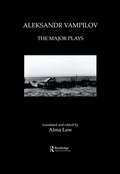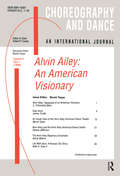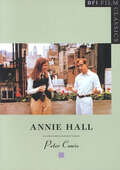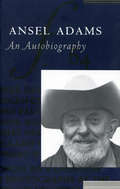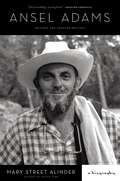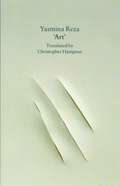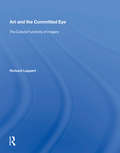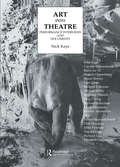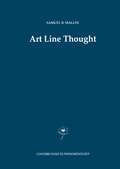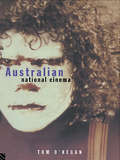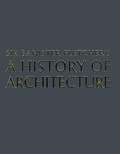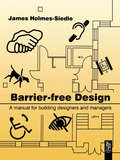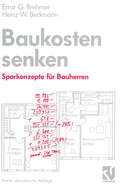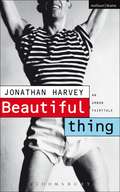- Table View
- List View
Aleksandr Vampilov: The Major Plays
by Alma LawFirst Published in 1996. Routledge is an imprint of Taylor & Francis, an informa company.
Aleksandr Vampilov: The Major Plays (Russian Theatre Archive Ser. #Vol. 6.)
by Alma LawFirst Published in 1996. Routledge is an imprint of Taylor & Francis, an informa company.
Alvin Ailey: An American Visionary (Choreography and Dance Studies Series)
by Muriel TopazDuring its three and half decades, the Alvin Ailey Company has left lasting markers on the playing field of American Modern Dance. It has established a reputation for precise but spectacular dancing, for depicting an African American ethos with sensitivity and elegance, and set standards for performance excellence. Ailey's choreography caused shock waves in the dance world of 1958 and continues to move audiences deeply. The company has also provided a paradigm for a modern dance repertory company. Contributors include Jennifer Dunning, Ronni Favors, Allan Gray, Denise Jefferson, Cynthia Sithembile West, Muriel Topaz, James Truitte, and Sylvia Waters. Eulogies written by David Dinkins, Carmen de Lavallade, Judith Jamison and Maya Angelou.
Alvin Ailey: An American Visionary (Choreography and Dance Studies Series #4.1)
by Muriel TopazDuring its three and half decades, the Alvin Ailey Company has left lasting markers on the playing field of American Modern Dance. It has established a reputation for precise but spectacular dancing, for depicting an African American ethos with sensitivity and elegance, and set standards for performance excellence. Ailey's choreography caused shock waves in the dance world of 1958 and continues to move audiences deeply. The company has also provided a paradigm for a modern dance repertory company. Contributors include Jennifer Dunning, Ronni Favors, Allan Gray, Denise Jefferson, Cynthia Sithembile West, Muriel Topaz, James Truitte, and Sylvia Waters. Eulogies written by David Dinkins, Carmen de Lavallade, Judith Jamison and Maya Angelou.
Annie Hall: A Nervous Romance (BFI Film Classics)
by Peter CowieFor an entire generation, 'Annie Hall 'embodied the notion of a New York peopled by sophisticated intellectuals - all sent up by the deadpan comedy genius of Woody Allen, writer, director and of course star. It also confirmed the sparkling acting talent of Diane Keaton as a partner for Woody on screen. The film has survived as a popular comedy, however, by virtue of Allen's inventiveness as a director and the timelessness of his satire. Peter Cowrie's study of 'Annie Hall 'recaptures the mood of the 70s, and examines the myriad imaginative touches that distinguish this film from other American productions of the period. The book also includes a glossary of the many cultural references which give the film its distinctively 'intellectual' tone.
Ansel Adams: An Autobiography
by Ansel Adams Mary Street AlinderDiscover this "evocative celebration of the life, career, friendships, concerns, and vision" of Ansel Adams, America's greatest photographer (New York Times)"No lover of Ansel Adams' photographs can afford to miss this book." - Wallace Stegner In this bestselling autobiography, completed shortly before his death in 1984, Ansel Adams looks back at his legendary six-decade career as a conservationist, teacher, musician, and, above all, photographer.Illustrated with eight pages of Adams' gorgeous black-and-white photographs, this book brings readers behind the images into the stories and circumstances of their creation. Written with characteristic warmth, vigor, and wit, this fascinating account brings to life the infectious enthusiasms, fervent battles, and bountiful friendships of a truly American original. "A warm, discursive, and salty document." - New Yorker
Ansel Adams: A Biography
by Mary Street AlinderFirst published in 1996, Mary Street Alinder's biography of Ansel Adams remains the only full biography of one of the greatest American photographers. Alinder is a respected scholar, and also had a close connection to Adams, serving as his chief assistant in the last five years of his life. The portrait she creates of him is intimate and affectionate; it is also clear-eyed. She takes on his difficult childhood in San Francisco, the friendships and rivalries within his circle of photographers, his leadership in America's environmental movement, his marriage, his affairs, and his not-always-successful fatherhood. Enriched by her uniquely personal understanding of Adams the man, she explains the artistic philosophy that, paired with his peerless technique, produced an inimitable style. Her biography is likely to remain unrivaled.This new edition will bring the classic up to date and includes research that reveals new information and a deeper understanding of his greatest photographs. It will also include thirty-two pages of reproductions of Adams's work and snapshots of the artist and close friends.
Ansel Adams: An Autobiography
by Mary Street Alinder Ansel AdamsDiscover this "evocative celebration of the life, career, friendships, concerns, and vision" of Ansel Adams, America's greatest photographer (New York Times)"No lover of Ansel Adams' photographs can afford to miss this book." - Wallace Stegner In this bestselling autobiography, completed shortly before his death in 1984, Ansel Adams looks back at his legendary six-decade career as a conservationist, teacher, musician, and, above all, photographer.Illustrated with eight pages of Adams' gorgeous black-and-white photographs, this book brings readers behind the images into the stories and circumstances of their creation. Written with characteristic warmth, vigor, and wit, this fascinating account brings to life the infectious enthusiasms, fervent battles, and bountiful friendships of a truly American original. "A warm, discursive, and salty document." - New Yorker
Art
by Yasmina Reza Christopher HamptonSerge has bought a modern work of art for a large sum of money. Marc hates the painting and cannot believe that a friend of his could possibly want such a work. Yvan attempts, unsuccessfully, to placate both sides with hilarious consequences. The question is: Are you who you think you are or are you who your friends think you are?
Art And The Committed Eye: The Cultural Functions Of Imagery
by Richard LeppertIn Art and the Committed Eye Richard Leppert examines Western European and American art from the fifteenth to the twentieth century. He studies the complex relation between the "look" of images and the variety of social and cultural uses to which they are put and demonstrates that the meaning of any image is significantly determined by its function, which changes over time. In particular, he emphasizes the ways in which visual culture is called on to mediate social differences defined by gender, class, and race. In , Leppert addresses the nature and task of representation, discussing how meaning accrues to images and what role vision and visuality play in the history of modernity. Here he explains imagery's power to attract our gaze by triggering desire and focuses on the long history of the use of representation to enact a deception, whether in painting or advertising. explores art's relation to the material world, to the ways in which images mark our various physical and psychic ties to objects. The author analyzes still life paintings whose subject matter is both extraordinarily diverse and deeply paradoxical—from flower bouquets to grotesque formal arrangements of human body parts. Leppert demonstrates that even in "innocent" still lifes, formal design and technical execution are imbued with cultural conflict and social power. is devoted to the representation of the human body—as subject to obsessive gazing and as an object of display, spectacle, and transgression. The variety of body representation is enormous: pleased or tortured, gorgeous or monstrous, modest or lascivious, powerful or weak, in the bloom of life or under the anatomist's knife, clothed or naked. But it is the sexual body, Leppert shows, that has provided the West with its richest, most complex, contradictory, conflicted, and paradoxical accounts of human identity in relation to social ideals.
Art And The Committed Eye: The Cultural Functions Of Imagery
by Richard LeppertIn Art and the Committed Eye Richard Leppert examines Western European and American art from the fifteenth to the twentieth century. He studies the complex relation between the "look" of images and the variety of social and cultural uses to which they are put and demonstrates that the meaning of any image is significantly determined by its function, which changes over time. In particular, he emphasizes the ways in which visual culture is called on to mediate social differences defined by gender, class, and race. In , Leppert addresses the nature and task of representation, discussing how meaning accrues to images and what role vision and visuality play in the history of modernity. Here he explains imagery's power to attract our gaze by triggering desire and focuses on the long history of the use of representation to enact a deception, whether in painting or advertising. explores art's relation to the material world, to the ways in which images mark our various physical and psychic ties to objects. The author analyzes still life paintings whose subject matter is both extraordinarily diverse and deeply paradoxical—from flower bouquets to grotesque formal arrangements of human body parts. Leppert demonstrates that even in "innocent" still lifes, formal design and technical execution are imbued with cultural conflict and social power. is devoted to the representation of the human body—as subject to obsessive gazing and as an object of display, spectacle, and transgression. The variety of body representation is enormous: pleased or tortured, gorgeous or monstrous, modest or lascivious, powerful or weak, in the bloom of life or under the anatomist's knife, clothed or naked. But it is the sexual body, Leppert shows, that has provided the West with its richest, most complex, contradictory, conflicted, and paradoxical accounts of human identity in relation to social ideals.
Art Into Theatre: Performance Interviews and Documents (Contemporary Theatre Studies #Vol. 16.)
by Nick KayeArt Into Theatre investigates the processes of hybrid forms of performance developed between 1952 and 1994 through a series of interviews with key practitioners and over 80 pieces of documentation, many previously unpublished, of the works under discussion.Ranging from the austerity of Cage's 4'33" through the inter-species communication of Schneeman's Cat Scanand the experimental theatre work of Schechner, Foreman, and Kirby, to the recent performances of Abramovic, Forced Entertainment and the Wooster Group, Art Into Theatre offers a fascinating collection of perspectives on the destabilizing of conventional ideas of the art "object" and the theatrical "text". Nick Kaye's introductory essay to the volume offers a useful context for the reader and each interview is preceded by an informative biographical sketch.
Art Into Theatre: Performance Interviews and Documents
by Nick KayeArt Into Theatre investigates the processes of hybrid forms of performance developed between 1952 and 1994 through a series of interviews with key practitioners and over 80 pieces of documentation, many previously unpublished, of the works under discussion.Ranging from the austerity of Cage's 4'33" through the inter-species communication of Schneeman's Cat Scanand the experimental theatre work of Schechner, Foreman, and Kirby, to the recent performances of Abramovic, Forced Entertainment and the Wooster Group, Art Into Theatre offers a fascinating collection of perspectives on the destabilizing of conventional ideas of the art "object" and the theatrical "text". Nick Kaye's introductory essay to the volume offers a useful context for the reader and each interview is preceded by an informative biographical sketch.
Art Line Thought (Contributions to Phenomenology #21)
by S.B. MallinArt Line Thought discusses the main issues that beset our time and philosophy by locating these same issues in artworks and describing closely what is shown there. While respecting their differences, art and philosophy are thus made to cross back and forth into one another, delineating in fresh ways our concerns about nature, the human and non-human, the body, femininity, ecology, technology, textism, the end of history, community, postmodernism, relativism and non-Eurocentric ethics. A `philosophy of line' gathers these issues, opposing the current dominance of `word' and linguistic analyses. Art has long been aware that the line communicates meaning at least as well as the word. The volume is divided between contemporary and prehistoric art in order to reveal the presumptions of `Western' culture and how we might move beyond it. Since the book is a critique of Eurocentric thinking and prose, it works at finding new styles of both. Its philosophical meditation is directed equally to those who are intellectually interested in contemporary and prehistoric art, in theories of postmodern culture and criticism, and in anthropology.
Australian National Cinema
by Tom O'ReganTom O'Regan's book is the first of its kind on Australian post-war cinema. It takes as its starting point Bazin's question 'What is cinema?'and asks what the construct of a 'national' cinema means. It looks at the broader concept from a different angle, taking film beyond the confines of 'art' into the broader cultural world. O'Regan's analysis situates Australian cinema in its historical and cultural perspective producing a valuable insight into the issues that have been raised by film policy, the cinema market place and public discourse on film production strategies. Since 1970 Australian film has enjoyed a revival. This book contains detailed critiques of the key films of this period and uses them to illustrate the recent theories on the international and Australian cinema industries. Its conclusions on the nature of the nation's cinema and the discourses within it are relevant within a far wider context; film as a global phenomenon.
Australian National Cinema
by Tom O'ReganTom O'Regan's book is the first of its kind on Australian post-war cinema. It takes as its starting point Bazin's question 'What is cinema?'and asks what the construct of a 'national' cinema means. It looks at the broader concept from a different angle, taking film beyond the confines of 'art' into the broader cultural world. O'Regan's analysis situates Australian cinema in its historical and cultural perspective producing a valuable insight into the issues that have been raised by film policy, the cinema market place and public discourse on film production strategies. Since 1970 Australian film has enjoyed a revival. This book contains detailed critiques of the key films of this period and uses them to illustrate the recent theories on the international and Australian cinema industries. Its conclusions on the nature of the nation's cinema and the discourses within it are relevant within a far wider context; film as a global phenomenon.
Banister Fletcher's A History Of Architecture (Part 1 of 7) (PDF)
by Banister Fletcher Dan Cruickshank Peter Blundell Jones Kenneth Frampton Andrew SaintThe 20th edition of Sir Banister Fletcher's A History of Architecture is the first major work of history to include an overview of the architectural achievements of the 20th Century. Banister Fletcher has been the standard one volume architectural history for over 100 years and continues to give a concise and factual account of world architecture from the earliest times. In this twentieth and centenary edition, edited by Dan Cruickshank with three consultant editors and fourteen new contributors, chapters have been recast and expanded and a third of the text is new. * There are new chapters on the twentieth-century architecture of the Middle East (including Israel), South-east Asia, Hong Kong, Japan and Korea, the Indian subcontinent, Russia and the Soviet Union, Eastern Europe and Latin America. * The chapter on traditional architecture of India has been rewritten and the section on traditional Chinese architecture has been expanded, both with new specially commissioned drawings * The architecture of the Americas before 1900 has been enlarged to include, for the first time, detailed coverage of Latin America and the Caribbean * The book's scope has been widened to include more architecture from outside Europe * The bibliography has been expanded into a separate section and is a key source of information on every period of world architecture * The coverage of the 20th century architecture of North America has been divided into two chapters to allow fuller coverage of contemporary works * 20th century architecture of Western Europe has been radically recast * For the first time the architecture of the twentieth century is considered as a whole and assessed in an historical perspective * Coverage has been extended to include buildings completed during the last ten years * The coverage of Islamic architecture has been increased and re-organised to form a self contained section This unique reference book places buildings in their social, cultural and historical settings to describe the main patterns of architectural development, from Prehistoric to the International Style. Again in the words of Sir Banister Fletcher, this book shows that 'Architecture . . . provides a key to the habits, thoughts and aspirations of the people, and without a knowledge of this art the history of any period lacks that human interest with which it should be invested. '
Banister Fletcher's A History Of Architecture (Part 2 of 7) (PDF)
by Banister Fletcher Dan Cruickshank Peter Blundell Jones Kenneth Frampton Andrew SaintThe 20th edition of Sir Banister Fletcher's A History of Architecture is the first major work of history to include an overview of the architectural achievements of the 20th Century. Banister Fletcher has been the standard one volume architectural history for over 100 years and continues to give a concise and factual account of world architecture from the earliest times. In this twentieth and centenary edition, edited by Dan Cruickshank with three consultant editors and fourteen new contributors, chapters have been recast and expanded and a third of the text is new. * There are new chapters on the twentieth-century architecture of the Middle East (including Israel), South-east Asia, Hong Kong, Japan and Korea, the Indian subcontinent, Russia and the Soviet Union, Eastern Europe and Latin America. * The chapter on traditional architecture of India has been rewritten and the section on traditional Chinese architecture has been expanded, both with new specially commissioned drawings * The architecture of the Americas before 1900 has been enlarged to include, for the first time, detailed coverage of Latin America and the Caribbean * The book's scope has been widened to include more architecture from outside Europe * The bibliography has been expanded into a separate section and is a key source of information on every period of world architecture * The coverage of the 20th century architecture of North America has been divided into two chapters to allow fuller coverage of contemporary works * 20th century architecture of Western Europe has been radically recast * For the first time the architecture of the twentieth century is considered as a whole and assessed in an historical perspective * Coverage has been extended to include buildings completed during the last ten years * The coverage of Islamic architecture has been increased and re-organised to form a self contained section This unique reference book places buildings in their social, cultural and historical settings to describe the main patterns of architectural development, from Prehistoric to the International Style. Again in the words of Sir Banister Fletcher, this book shows that 'Architecture . . . provides a key to the habits, thoughts and aspirations of the people, and without a knowledge of this art the history of any period lacks that human interest with which it should be invested. '
Banister Fletcher's A History Of Architecture (Part 3 of 7) (PDF)
by Banister Fletcher Dan Cruickshank Peter Blundell Jones Kenneth Frampton Andrew SaintThe 20th edition of Sir Banister Fletcher's A History of Architecture is the first major work of history to include an overview of the architectural achievements of the 20th Century. Banister Fletcher has been the standard one volume architectural history for over 100 years and continues to give a concise and factual account of world architecture from the earliest times. In this twentieth and centenary edition, edited by Dan Cruickshank with three consultant editors and fourteen new contributors, chapters have been recast and expanded and a third of the text is new. * There are new chapters on the twentieth-century architecture of the Middle East (including Israel), South-east Asia, Hong Kong, Japan and Korea, the Indian subcontinent, Russia and the Soviet Union, Eastern Europe and Latin America. * The chapter on traditional architecture of India has been rewritten and the section on traditional Chinese architecture has been expanded, both with new specially commissioned drawings * The architecture of the Americas before 1900 has been enlarged to include, for the first time, detailed coverage of Latin America and the Caribbean * The book's scope has been widened to include more architecture from outside Europe * The bibliography has been expanded into a separate section and is a key source of information on every period of world architecture * The coverage of the 20th century architecture of North America has been divided into two chapters to allow fuller coverage of contemporary works * 20th century architecture of Western Europe has been radically recast * For the first time the architecture of the twentieth century is considered as a whole and assessed in an historical perspective * Coverage has been extended to include buildings completed during the last ten years * The coverage of Islamic architecture has been increased and re-organised to form a self contained section This unique reference book places buildings in their social, cultural and historical settings to describe the main patterns of architectural development, from Prehistoric to the International Style. Again in the words of Sir Banister Fletcher, this book shows that 'Architecture . . . provides a key to the habits, thoughts and aspirations of the people, and without a knowledge of this art the history of any period lacks that human interest with which it should be invested. '
Banister Fletcher's A History Of Architecture (Part 4 of 7) (PDF)
by Banister Fletcher Dan Cruickshank Peter Blundell Jones Kenneth Frampton Andrew SaintThe 20th edition of Sir Banister Fletcher's A History of Architecture is the first major work of history to include an overview of the architectural achievements of the 20th Century. Banister Fletcher has been the standard one volume architectural history for over 100 years and continues to give a concise and factual account of world architecture from the earliest times. In this twentieth and centenary edition, edited by Dan Cruickshank with three consultant editors and fourteen new contributors, chapters have been recast and expanded and a third of the text is new. * There are new chapters on the twentieth-century architecture of the Middle East (including Israel), South-east Asia, Hong Kong, Japan and Korea, the Indian subcontinent, Russia and the Soviet Union, Eastern Europe and Latin America. * The chapter on traditional architecture of India has been rewritten and the section on traditional Chinese architecture has been expanded, both with new specially commissioned drawings * The architecture of the Americas before 1900 has been enlarged to include, for the first time, detailed coverage of Latin America and the Caribbean * The book's scope has been widened to include more architecture from outside Europe * The bibliography has been expanded into a separate section and is a key source of information on every period of world architecture * The coverage of the 20th century architecture of North America has been divided into two chapters to allow fuller coverage of contemporary works * 20th century architecture of Western Europe has been radically recast * For the first time the architecture of the twentieth century is considered as a whole and assessed in an historical perspective * Coverage has been extended to include buildings completed during the last ten years * The coverage of Islamic architecture has been increased and re-organised to form a self contained section This unique reference book places buildings in their social, cultural and historical settings to describe the main patterns of architectural development, from Prehistoric to the International Style. Again in the words of Sir Banister Fletcher, this book shows that 'Architecture . . . provides a key to the habits, thoughts and aspirations of the people, and without a knowledge of this art the history of any period lacks that human interest with which it should be invested. '
Barrier-Free Design
by James Holmes-SeidleThis book for architects, interior designers, building managers, students, conference organisers looks at first principles to provide the user with the 'tools' to make their own decisions rather than a 'cookbook' approach. It is intended that designs and product information can be taken straight from the manual and inserted into ongoing projects. For the first time the book considers the needs of people with visual, hearing and mental disabilities, who make up the majority of disabled people in the population, alongside those of people with physical mobility disabilities. Practical low cost solutions to retro-fitting existing buildings are discussed, as well as the methods used to assess the suitability of an existing building, and assembling a project to improve access for disabled people. Specific products and designs are illustrated and discussed - with full working technical drawings, and full specification details. These will reduce considerably the research time needed to produce a cost-effective solution that will improve access for disabled people. A perspective of the standards and legislation dealing with access issues in the UK is compared with those in other countries, and the standards mentioned are compared with the realities of practical implementation carried out in 4 years of design in this area.
Barrier-Free Design
by James Holmes-SeidleThis book for architects, interior designers, building managers, students, conference organisers looks at first principles to provide the user with the 'tools' to make their own decisions rather than a 'cookbook' approach. It is intended that designs and product information can be taken straight from the manual and inserted into ongoing projects. For the first time the book considers the needs of people with visual, hearing and mental disabilities, who make up the majority of disabled people in the population, alongside those of people with physical mobility disabilities. Practical low cost solutions to retro-fitting existing buildings are discussed, as well as the methods used to assess the suitability of an existing building, and assembling a project to improve access for disabled people. Specific products and designs are illustrated and discussed - with full working technical drawings, and full specification details. These will reduce considerably the research time needed to produce a cost-effective solution that will improve access for disabled people. A perspective of the standards and legislation dealing with access issues in the UK is compared with those in other countries, and the standards mentioned are compared with the realities of practical implementation carried out in 4 years of design in this area.
Baukosten senken: Sparkonzepte für Bauherren
by Ernst G. Brehmer Heinz BeckmannWer vom ersten bis zum letzten Schritt kostenbewußt planen und bauen will, braucht Rat aus Erfahrung. BAUKOSTEN SENKEN zeigt einfach, anschaulich und schnell, wo, wie und wann sich Geld beim Bauen sparen läßt. Baukosten senken: Nachprüfbare Tips, wie sich beim Neubau, beim Umbau eines Altbaus, beim Erwerb von Eigentumswohnungen und Fertighäusern, bei der Wahl der Fachleute - vom Architekten bis zum Kostenberater - und nicht zuletzt der Handwerker - bis zu 30 % einsparen lassen. Baukosten senken: Sparbuch, Ratgeber und Nachschlagewerk in einem Band. Baukosten senken: Planung, Kontrolle, Minimierung. Das Standardwerk für kostenbewußte Bauherren in vollständig überarbeiteter und aktualisierter Fassung.
Beautiful Thing: Screenplay (Screen and Cinema)
by Jonathan HarveyPremiered at the Bush theatre in 1993 Beautiful Thing was released as a feature film by Channel Four films in 1996 directed by Hettie Macdonald and featuring Meera SyalBeautiful Thing explores pre-teenage homo-erotic sensuality and the frictions and intimacies of living cheek by jowl on a Thamesmead housing estate.
Best Development Practices: Doing the Right Thing and Making Money at the Same Time
by Reid EwingThe author draws upon case examples of some of today's most acclaimed developments in this book, and recommends best practice guidelines to help developers create vibrant, livable communities-and still make money. For years, Florida's planners and developers have had to deal with some of the most difficult growth management problems. Now planners and developers across the nation can benefit from the valuable lessons Florida offers on combating urban sprawl. Ewing first searched the state for the best contemporary developments, then distilled their lessons into guidelines for directing new development and assessing the quality of existing development. The 43 practices outlined in this exciting book cover four areas of development-land use, transportation, the environment, and housing. They apply to a broad range of development projects, including small planned communities, residential subdivisions, and commercial centers. The book's recommendations are based upon the experiences of successful developers and supported by empirical research. The proof lies in the compelling real-world examples Ewing highlights throughout the text. Illustrated with dozens of photographs and written in a lively style, this book is must reading for all those seeking better ways to plan and design communities. Developers will find proven, feasible land development regulations and benchmarks against which to evaluate development proposals.
